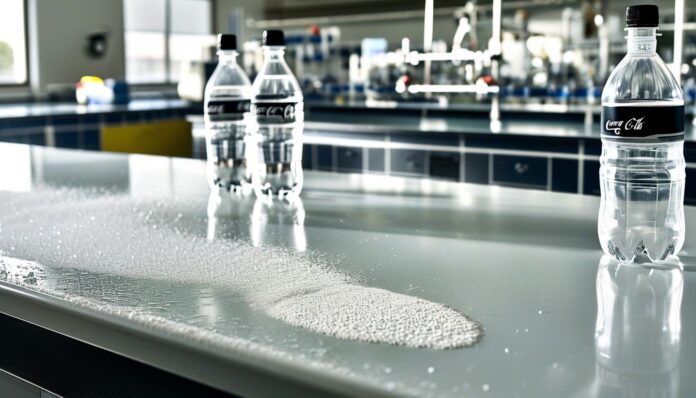Orthophosphoric acid (H₃PO₄), commonly known as phosphoric acid, is a mineral acid used in a wide range of industries. It is a clear, odorless liquid or crystalline solid that is soluble in water. The compound plays a crucial role due to its acidic properties and ability to act as a buffering agent. Below are its primary uses:
1. Food and Beverage Industry
Orthophosphoric acid is widely used as a food additive, particularly in carbonated beverages. It gives soft drinks, like colas, their tangy flavor while acting as an acidulant and preservative. It’s also employed in the production of processed foods and cheese.
- Flavoring Agent: Adds a sharp, tangy taste to soft drinks and processed foods.
- Preservative: Extends shelf life by inhibiting the growth of bacteria and mold.
- Acidulant: Helps control the acidity level in foods.
2. Cleaning Products
Orthophosphoric acid is a powerful cleaning agent, often used in the removal of rust and mineral deposits. It can be found in metal cleaning products and industrial descalers.
- Rust Removal: Converts rust (iron oxide) into a water-soluble form, making it easier to clean metals.
- Descaler: Removes mineral deposits from surfaces, pipes, and equipment.
3. Water Treatment
Orthophosphoric acid is used in water treatment facilities as a corrosion inhibitor. By forming a protective film on metal surfaces, it helps prevent the corrosion of pipes and equipment in water systems.
- Corrosion Inhibitor: Protects water pipes by forming a protective phosphate layer.
- Water Softening: Prevents the build-up of limescale and other deposits in industrial water systems.
Interesting Facts about Orthophosphoric Acid
- Discovery and Historical Use: Orthophosphoric acid was first produced in 1769 by German chemist Johann Gottlieb Gahn through the treatment of phosphates with sulfuric acid. This process is still used today in modern production.
- Key Role in Soft Drink Industry: One of the most iconic uses of orthophosphoric acid is in cola beverages. Its sharp tangy taste, along with caffeine and sugar, gives cola its signature flavor. However, there has been controversy over its health effects, as overconsumption of phosphoric acid in sodas has been linked to lower bone density.
- The Great Soda Controversy: In the early 2000s, several studies suggested a potential link between phosphoric acid in cola and an increased risk of osteoporosis, particularly in women. This led to widespread debate about the safety of soft drinks. Although definitive links remain inconclusive, it led to a reduction in the use of phosphoric acid in certain beverages.
- Rust Removal Incident: In 1995, an industrial plant in Texas used orthophosphoric acid to remove rust from their steel equipment. However, due to improper handling, the acid spilled, causing localized environmental damage. This incident highlighted the need for stringent safety measures in industrial use.
- Fertilizer Explosion: Phosphoric acid is a precursor in the production of ammonium phosphate fertilizers, and improper handling of these chemicals can be hazardous. In 1947, the Texas City disaster occurred when a ship carrying ammonium nitrate (a phosphate-based fertilizer) exploded, causing one of the deadliest industrial accidents in U.S. history. Though orthophosphoric acid was not directly involved, its role in fertilizer production has raised concerns about safe storage and handling.
- Medical Application: In the field of dentistry, phosphoric acid is a common component of dental etchants used to prepare tooth surfaces for bonding. An interesting medical fact is that orthophosphoric acid has been shown to improve the bonding strength of dental fillings, making it a crucial part of modern dental care.
- Phosphate Detergents Ban: In the 1960s and 1970s, phosphate-based detergents (derived from orthophosphoric acid) were widely used. However, these detergents were later banned or restricted in many countries because of their contribution to water pollution and eutrophication (excessive algae growth) in lakes and rivers. This led to a shift toward more eco-friendly detergent alternatives.
- Corrosion-Prevention in Mars Exploration: Orthophosphoric acid has been studied for its potential use in preventing corrosion in spacecraft. NASA has experimented with phosphate coatings to protect metal components in harsh environments like those found on Mars, where temperature fluctuations and dust storms can rapidly degrade equipment.
- Cultural Reference: Orthophosphoric acid’s role in cola has even made its way into popular culture. In the mid-1990s, there was a fictional urban legend claiming that if you left a nail in a glass of cola overnight, it would dissolve completely due to the phosphoric acid content. While exaggerated, this tale captured the public’s imagination and increased awareness about the acid’s potent nature.
- Fertilizer and Global Agriculture: Phosphoric acid is critical for global food production, as it is a major component of fertilizers that support crop growth. With increasing concerns over soil degradation and the rising demand for food, phosphoric acid remains essential in modern agriculture, though sustainable alternatives are being explored.
